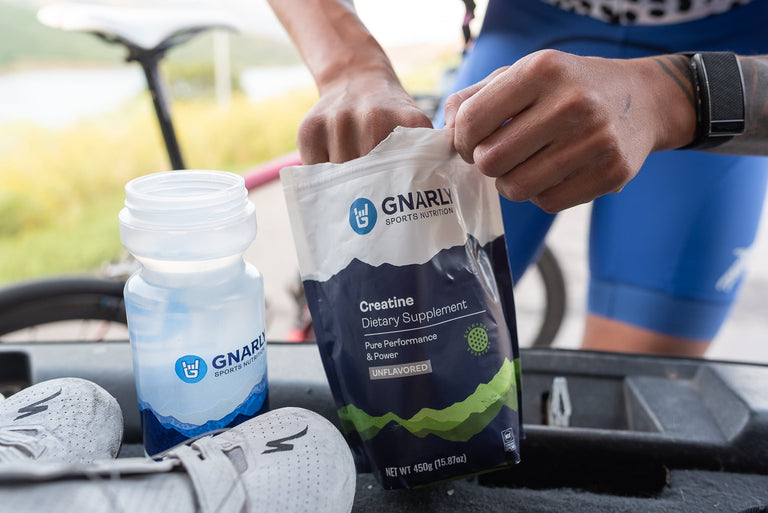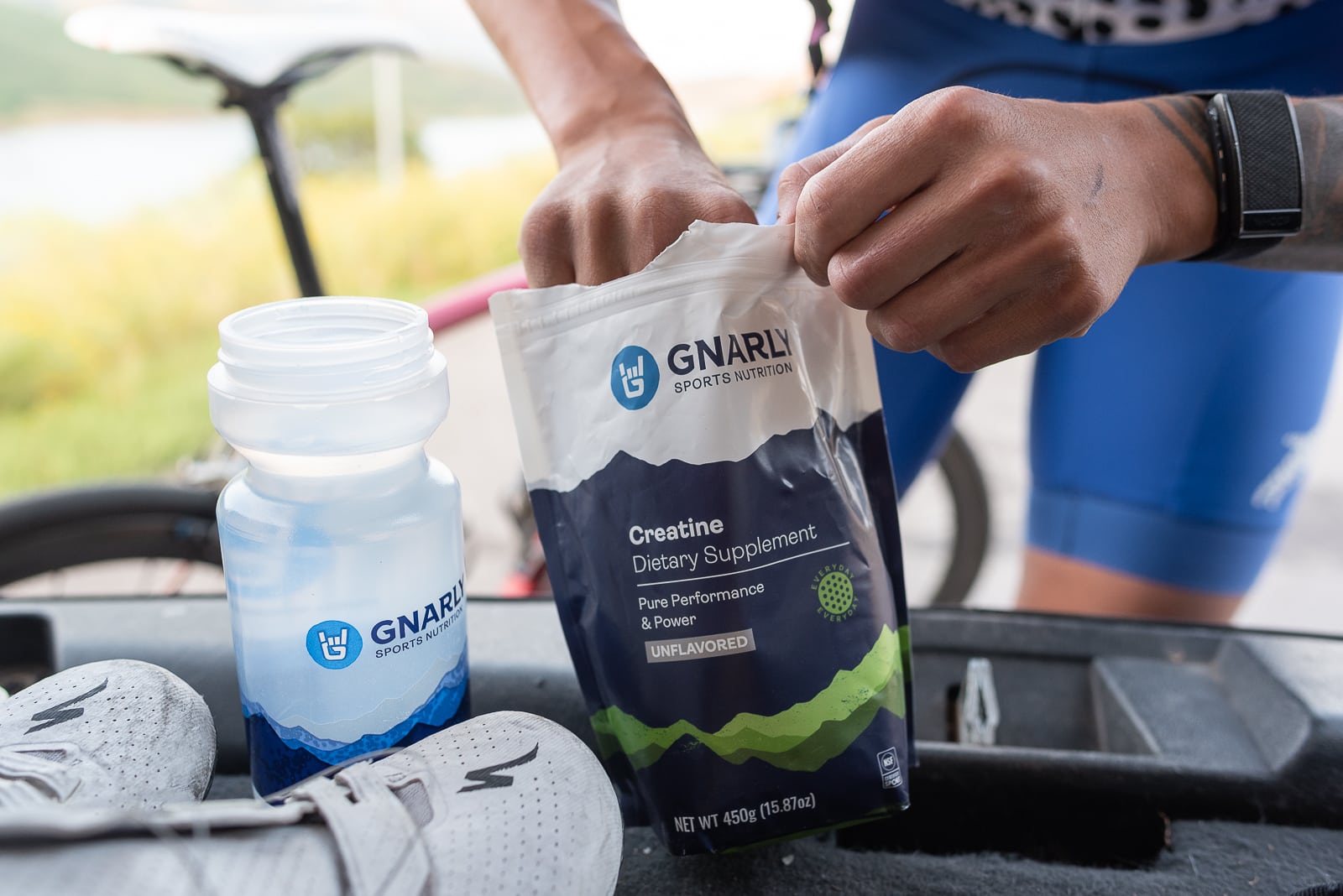Creatine is one of the most well-researched supplements with robust evidence for a plethora of benefits for athletes young and old. Despite this, there are many misconceptions about creatine. Before debunking some of the most common myths, it’s important to understand what creatine is and what it does in the body.
What is creatine?
Creatine is actually an amino acid naturally produced in the body and primarily located in the skeletal muscle with small amounts also found in the brain and testes. The liver and kidneys make about half of the creatine our body needs. The other half is obtained from our diet, which is primarily found in meat and seafood.
Most of the creatine in our muscle is in the form of phosphocreatine, which plays an important role in maintaining energy availability (helping our bodies make ATP), especially during high-intensity, short duration activities or repeated bouts of exercise with short rests like resistance training and stop-go sports. This is known as the phosphocreatine system. It also plays an antioxidant role by reducing the formation of reactive oxygen species (free radicals) and increases anaerobic threshold via creatine-phosphocreatine buffering, which may benefit endurance focused athletes. These pivotal roles may explain why supplementation may be so beneficial for athletes.
Top 7 Myths:
1. Creatine causes dehydration & muscle cramps
This myth seemed to have originated from anecdotal evidence that users perceived creatine to have negative effects such as cramping and dehydration in two surveys in athletes. However, the results of these were confounded by participants using other supplements and various dosages of creatine.(1) One study in 72 collegiate football players gave players either creatine or sport drink placebo during the football season. Creatine actually had significantly less cramping, heat illness, dehydration, muscle tightness, and total injuries compared to the placebo group.(2) Clinically, creatine helped to reduce muscle cramping in patients receiving hemodialysis (a procedure that filters the blood through a machine that works like artificial kidneys).(3)
2. Creatine is only helpful for men
While the majority of research on creatine has been conducted in males, current research suggests females of various levels of training, fitness, age and in various sports/activities in both anaerobic and aerobic exercise may benefit from both short term and long term creatine supplementation (4). Creatine supplementation with a loading and maintenance phase (20 grams daily, separated into four, 5-gram doses) in collegiate female soccer players during a 13-week resistance training led to significant increases in strength compared to the placebo group.(5) Other studies on untrained females also indicate that supplementation is effective for improving strength and power.

One study evaluated a 7 day creatine loading on exercise performance on a stationary bike. It showed that supplementation increased total test time and lower VO2 and heart rate compared to the placebo.(6)
While the above studies were conducted in menstruating females, there are multiple studies evaluating short-term creatine supplementation in post-menopausal females. It may actually help counter the decrease in muscle and strength by reducing inflammation and oxidative stress. Many of these studies also use higher loading doses, around 20 grams daily. Two long-term (52 weeks) studies on post-menopausal women suggest lower doses of 1-3 grams per day weren’t effective on fat free mass, bone density, or muscle function. However, one study evaluating creatine supplementation of around 7 grams daily combined with resistance training over 52 weeks found reduced rate of bone mineral density loss in the hip region and increased upper body strength compared to the placebo, but findings from other studies didn’t have positive effects on bone.(7,8)
Overall, post-menopausal females may benefit from high dose creatine of about 0.3 g/kg/day for at least 5-7 days, and at least 5 grams daily for improving muscle and strength in post-menopausal females.
3. Creatine is only helpful for those who engage in resistance- or power- or high-intensity activities
Creatine supplementation might benefit athletes in sports outside of high-intensity intermittent sports and lifting, given that just about every sport will include some level of high intensity output. One study found that runners who regularly supplemented with creatine experienced less muscle damage, soreness, and inflammation after a 30 km run.(9)
From reducing muscle damage, enhancing recovery from intense exercise, to possibly reducing injury risk, athletes of most disciplines would benefit from supplementation. There are even multiple studies that suggest creatine may help one hyper-hydrate, which can improve heat tolerance.(10)
There is also some weak evidence that creatine may be neuroprotective when taken before or after a traumatic brain injury (TBI: concussion). However, research is not robust in this area, and warrants further investigation. Given the possible neuroprotective benefits, supplementation may be helpful for individuals participating in sports with high concussion risks.(11)
4. Creatine requires a “loading” phase
Many studies evaluating creatine supplementation suggest that a loading phase maximally increases skeletal muscle stores. This loading phase is defined by taking 20-25 grams daily (four, 5 gram doses throughout the day) for 5-7 days followed by a maintenance phase of 3-5 grams daily. Alternatively, loading could be done by body mass: 0.3 g/kg/day for 5-7 days followed by a maintenance phase.(1,4,10)
Many studies suggest that daily consistent creatine intake of 3-5 grams daily can increase creatine stores in the muscle and improve performance and recovery as well. However, it does delay maximum intramuscular creatine storage in comparison to a loading phase.(1,4,10)

Loading benefits someone looking to maximize the performance benefits in a short time frame (1-2 weeks), while someone without races/events in the near future may opt for maintenance dosing from the start (3-4 weeks). Additionally, females in particular may benefit from a loading phase.(1,4,10)
5. You can consume equal amounts of creatine from food as you can from a supplement
Creatine can be found in animal-based sources only. However, the creatine content of foods at even double a standard portion sizing is at most, less than 2 grams. The literature supports daily doses of 5 grams, or 20 grams if loading. Therefore, it would be difficult to consume the efficacious dose of creatine from food alone to reap the benefits.
Additionally, muscle creatine stores are lower in vegetarians compared to non-vegetarians, which makes sense considering food sources of creatine are mostly meat.(12) A systematic review of creatine supplementation in vegetarian athletes suggests supplementation increased lean body mass, muscular strength and endurance, power output, and brain function.(13)
|
Food |
Serving Size (oz) |
Creatine Content (grams) |
|
Beef |
3 |
0.8 |
|
Chicken Breast |
3 |
0.34 |
|
Ham |
3 |
0.8 |
|
Herring |
3 |
0.77 |
|
Salmon |
3 |
0.77 |
(14)
6. Creatine causes kidney damage
Because creatine is a string of amino acids known as a peptide, this misinformed myth may have originated from the myth that high protein intake leads to kidney damage in individuals with healthy kidneys. There is a false belief that consuming high creatine will overwork the kidneys, resulting in kidney damage and dysfunction. Many studies have evaluated this claim and have found no adverse effects from consuming recommended amounts.(1) However, individuals with compromised kidney function should speak with their primary care doctor or nephrologist before supplementing creatine as many of these individuals need to moderate protein intake.
7. Creatine causes water retention

There is some literature that supports that some individuals may experience some water retention in the first several days of supplementation. However, multiple longer term (5-10 weeks) studies evaluating supplementation with exercise have shown no increases in total body water, even at high doses of 20 grams per day.(1) For reference, most benefits of creatine can be achieved with as little as 3-5 grams per day. One study examining creatine supplementation with weight training found a significant increase in total body water and intra-cellular water, but the ratio of intra-cellular water to muscle mass was similar in the treatment group and placebo group. Intra-cellular water is important in increasing muscle mass over time.(15)
In conclusion, there is some evidence to support that it may cause water retention, there are many studies that suggest it does not, or it is altered relative to muscle mass over long periods of time.
In conclusion, many of the concerns regarding creatine supplementation are not supported by robust scientific literature. Creatine monohydrate may be one of the most efficacious supplements athletes of all levels and ages across multiple disciplines can take. Anyone looking to improve their high-intensity capacity and lean body mass, or vegetarian and vegan athletes, should consider taking a creatine supplement.
works cited
- Antonio, Jose, et al. “Common Questions and Misconceptions about Creatine Supplementation: What Does the Scientific Evidence Really Show?” Journal of the International Society of Sports Nutrition, vol. 18, no. 1, 2021, doi:10.1186/s12970-021-00412-w.
- Greenwood M, Kreider RB, Melton C, Rasmussen C, Lancaster S, Cantler E, Milnor P, Amanda A. Creatine supplementation during college football training does not increase the incidence of cramping or injury. MOl. Cell. Biochem. 2003;244;83-8.
- Chang CT, Wu CH, Yang CW, Huang JY, Wu MS. Creatine monohydrate treatment alleviates muscle cramps associated with haemodialysis. Nephrol. Dial. Transplant. 2002;17:1978-81.
- Smith-Ryan, Abbie E, et al. “Creatine Supplementation in Women’s Health: A Lifespan Perspective.” Nutrients, vol. 13, no. 3, 2021, p. 877., doi:10.3390/nu13030877.
- Larson-Meyer, D.E.; Hunter, G.R.; Trowbridge, C.A.; Turk, J.C.; Ernest, J.M.; Torman, S.; Harbin, P.A. The effect of creatine supplementation on muscle strength and body composition during off-season training in female soccer players, J. Strength Cond. Res. 2000, 14, 434-442.
- Nelson, A.G.; Day, R.; Glickman-Weiss, E.L.; Hegsted, M.; Kokkonen, J.; Sampson, B. Creatine supplementation alters the response to the graded cycle ergometer test. Eur. J. Appl. Phsiol. 2000, 83, 89-94.
- Sales, L.P,; Pinto, A.J.; Rodrigues, S.F.; Alvarenga, J.C.; SAmpaio-Barros, M.; Benatti, F.B.; Gualano, B.; Rodrigues Periera, R.M. Creatine Supplementation (3 g/d) and Bone Health in Older Women: A 2-Year, Randomized, Placebo-Controlled Trial, J. Gerontol, Er. A Boil, Sci, Med, Sci. 2020, 75, 931-938.
- Lobo, D.M.; Tritto, A.C.; da Silva, L.R.; de Oliveira, P.B.; Benatti, F.B.; Roschel, H.; Niess, B,; Gualano, B.; Pereira, R.M. Effects of long-term low-dose dietary creatine supplementation in older women. Exp. Gerontol. 2015, 70, 97-104.
- Santos RV, Bassit RA, Caperuto EC, Costa Rosa LF. The effect of creatine supplementation upon inflammatory and muscle soreness markers after a 30km race. Life Sci. 2004;75:1917–24.)
- Kreider, Richard B., et al. “International Society of Sports Nutrition POSITION STAND: Safety and Efficacy of Creatine Supplementation in EXERCISE, Sport, and Medicine.” Journal of the International Society of Sports Nutrition, vol. 14, no. 1, 2017, doi:10.1186/s12970-017-0173-z.
- Ainsley Dean, Philip John, et al. “Potential for Use of Creatine Supplementation Following Mild Traumatic Brain Injury.” Concussion, vol. 2, no. 2, 2017, doi:10.2217/cnc-2016-0016.
- Venderley, Angela M, and Wayne W Campbell. “Vegetarian Diets.” Sports Medicine, vol. 36, no. 4, 2006, pp. 293–305., doi:10.2165/00007256-200636040-00002.
- Kaviani, Mojtaba, et al. “Benefits of Creatine Supplementation for Vegetarians Compared to Omnivorous Athletes: A Systematic Review.” International Journal of Environmental Research and Public Health, vol. 17, no. 9, 2020, p. 3041., doi:10.3390/ijerph17093041.
- Wu, Guoyao. “Important Roles of Dietary Taurine, Creatine, Carnosine, Anserine and 4-Hydroxyproline in Human Nutrition and Health.” Amino Acids, vol. 52, no. 3, 2020, pp. 329–360., doi:10.1007/s00726-020-02823-6.
- Ribeiro AS, Avelar A, Kassiano W, Nunes JP, Schoenfeld BJ, Aguiar AF, Trindade MCC, Silva AM, Ardinha LB, Cyrino ES. Creatine Supplementation Does Not Influence The Ratio Between Intracellular Water and Skeletal Muscle Mass in Resistance-Trained Men. Int. J. Sport Nutr. Exrc. Metab. 2020:1-7.





